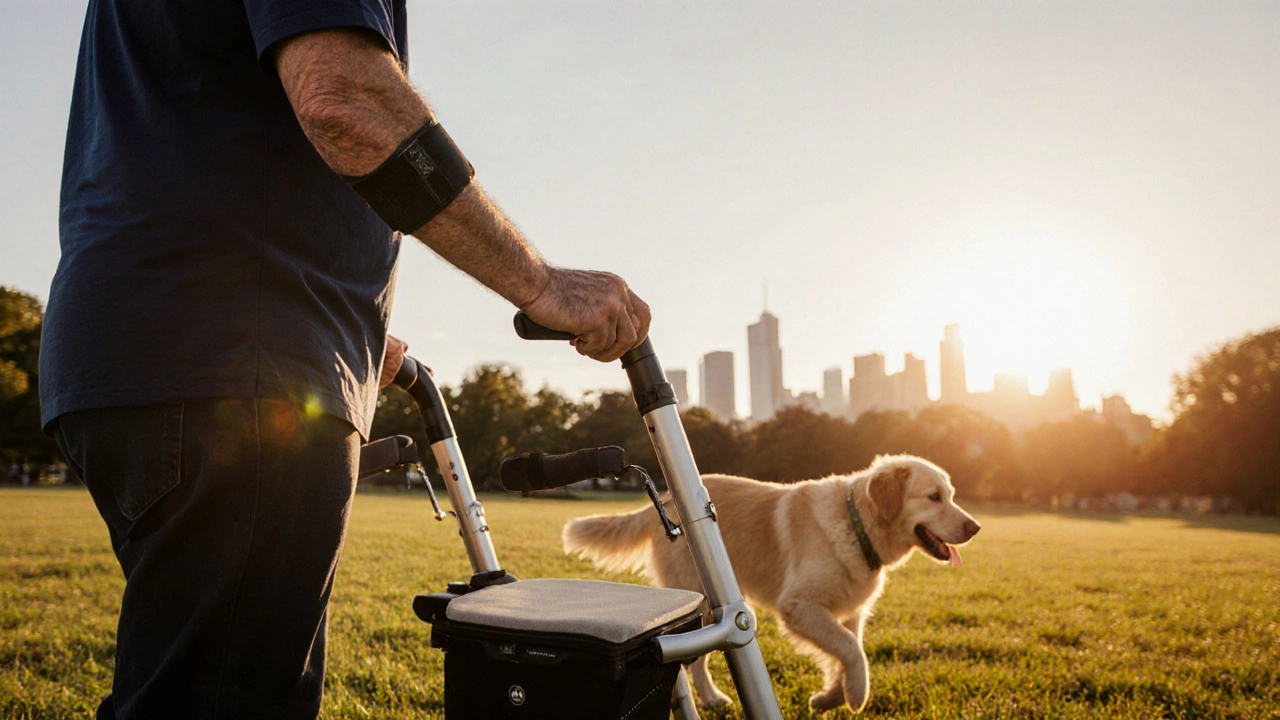
RA Assistive Device Selector
Select Your Main Affected Joints
What Daily Activities Do You Need Help With?
Living with rheumatoid arthritis (RA) often feels like a constant negotiation with your own body. The joint pain, swelling, and stiffness can turn simple tasks-like buttoning a shirt or reaching for a coffee mug-into painful obstacles. assistive devices step in as practical allies, easing strain, preserving function, and helping you stay independent. This guide walks you through the most common tools, how to choose the right ones, and where to get support.
Key Takeaways
- Assistive devices reduce joint stress and improve daily comfort for people with RA.
- Splints, adaptive utensils, and mobility aids are the three most common categories.
- Choosing a device starts with understanding your specific joint involvement and activity goals.
- Occupational therapists can tailor recommendations and ensure proper fit.
- Many devices are subsidised through Australian Medicare or private health funds.
What exactly is an assistive device?
When it comes to daily life, Assistive Device is a tool or piece of equipment designed to help people with physical limitations perform tasks more easily and safely. In the context of RA, these tools target joints that are most vulnerable-hands, wrists, elbows, knees, and ankles-by providing support, leverage, or alternative ways to grip.
Rheumatoid Arthritis: a quick snapshot
Rheumatoid Arthritis is an autoimmune disease that causes chronic inflammation of the joints, leading to pain, swollen tissues, and eventual loss of joint function. About 1% of the Australian adult population lives with RA, and the disease can affect anyone regardless of age or gender. The hallmark is symmetrical joint involvement, meaning both sides of the body are usually impacted.
Common Types of Assistive Devices for RA
Below are the four broad categories you’ll encounter most often. Each tackles a different set of challenges, from stabilising a swollen finger to reducing the effort needed to climb stairs.
Splints and Braces
Splint is a rigid or semi‑rigid support that holds a joint in a neutral position, limiting harmful movement while allowing safe motion. Splints are especially useful for fingers, wrists, and the thumb, where inflammation can make gripping painful. Braces, on the other hand, are often used for larger joints such as the knee or ankle, providing compression and alignment.
Adaptive Kitchen and Personal Care Tools
Adaptive Utensil is any kitchen or personal care tool that has been modified-usually with larger, ergonomically‑shaped handles-to reduce grip strength requirements. Think of jar openers with rubberized levers, angled knives, or toothbrushes with built‑in suction cups. These tools let you stay independent in the kitchen and bathroom without relying on a caregiver.
Mobility Aids
Mobility Aid is a device such as a cane, walker, or rollator that helps reduce weight‑bearing stress on the lower‑body joints. People with RA often experience knee and ankle pain, so a sturdy cane with an ergonomic handle can off‑load up to 30% of body weight from the affected leg.
Hand Exercisers and Therapeutic Tools
\nHand Exerciser is a small device-like a spring‑loaded grip trainer or a silicone stress ball-designed to improve hand strength and joint range of motion. Regular, low‑intensity exercise can reduce stiffness and maintain functional ability, especially when used under the guidance of a therapist.
Quick Comparison of Popular Devices
| Device | Primary Use | Ideal Joint(s) | Typical Material | Cost (AUD) |
|---|---|---|---|---|
| Finger Splint | Stabilise swollen fingers | Proximal & distal interphalangeal joints | Thermoplastic | 30‑80 |
| Wrist Brace | Limit painful wrist deviation | Wrist | Neoprene + metal stays | 45‑120 |
| Adaptive Kitchen Utensil | Reduce grip force needed | Hands & fingers | Silicone‑coated aluminum | 15‑50 per item |
| Rollator Walker | Support walking, provide seat | Knees, ankles | Aluminum frame | 150‑350 |
| Hand Grip Trainer | Build hand strength | Whole hand | Spring steel | 20‑70 |

How to Choose the Right Device for You
Picking an assistive device isn’t a one‑size‑fits‑all decision. Follow these steps to land on a tool that truly helps:
- Identify the most painful joints. Keep a simple diary for a week-note which activities trigger flare‑ups and which joints swell the most.
- Define your goal. Are you trying to protect a specific joint during daily chores, or do you need help walking longer distances?
- Test fit and comfort. Many pharmacies and medical supply stores allow you to try devices on‑site. Move the joint through its typical range; there should be no pinching or excessive pressure.
- Consider material and durability. Some people have skin sensitivities to neoprene or latex. Thermoplastic splints can be heat‑molded for a custom fit, while silicone handles are gentle on calloused fingers.
- Check cost and subsidies. Ask whether the device qualifies for Medicare’s Chronic Disease Management Plan, or if your private health insurer offers a rebate.
Working with an Occupational Therapist
Occupational Therapist is a health professional who evaluates a person’s ability to perform daily activities and prescribes adaptive strategies and equipment. In Australia, you can access OT services through a GP referral under the Chronic Disease Management plan. An OT will:
- Perform a hands‑on assessment of joint range, strength, and pain levels.
- Recommend specific devices (e.g., custom‑moulded splints) and demonstrate proper use.
- Teach joint‑protective techniques-like using larger tools or leveraging body mechanics-to reduce future wear.
Regular follow‑ups ensure the device remains effective as disease activity fluctuates.
Insurance, Funding, and Where to Buy
In Australia, several pathways can lower out‑of‑pocket costs:
- Medicare Chronic Disease Management (CDM) plan. Up to five allied‑health visits per year can be claimed, including occupational therapy.
- Private health insurance. Many policies cover “Aids and Appliances” with a nominal co‑payment.
- State‑based rebates. For example, the NSW Health Direct program offers discounts on select mobility aids.
- Pharmacy or medical supply stores. Chains like Chemist Warehouse stock basic splints and adaptive utensils, while specialist providers like “Assistive Design Australia” can create custom solutions.
Always keep receipts and a copy of your physician’s diagnosis-these documents are often required for subsidy approval.
Tips for Integrating Devices Into Daily Life
- Start slow. Wear a new splint for short periods (15‑20 minutes) and gradually increase as comfort improves.
- Combine with exercise. Light hand‑strengthening routines counteract any stiffness introduced by a brace.
- Keep devices clean. Wash silicone handles with mild soap; replace fabric liners on braces every few weeks to avoid skin irritation.
- Stay flexible. RA symptoms vary daily. Keep a spare set of devices (e.g., a lightweight cane) for flare‑up days.
Future Trends: Smart Assistive Tech
Wearable sensors are starting to appear in splints, alerting users via a smartphone app when a joint is being over‑used. 3‑D printing also enables truly custom‑fit devices at a lower cost. While still emerging, these innovations promise even more precise protection and user-friendly monitoring.
Frequently Asked Questions
Do I need a prescription to buy a splint?
Most basic splints can be purchased over the counter, but custom‑moulded splints usually require a prescription or a referral from your GP or occupational therapist.
Can assistive devices replace medication?
No. Devices work alongside disease‑modifying drugs to reduce mechanical stress and improve function, but they don’t address the underlying inflammation.
How often should I replace my brace?
Generally every 12‑18 months, or sooner if you notice loss of elasticity, tears, or skin irritation.
Are there tax deductions for assistive devices?
In Australia, eligible medical expenses-including certain assistive devices-can be claimed as a tax offset if you have a medical certificate. Consult a tax professional for specifics.
Can I use a walking stick indoors?
Yes. A lightweight cane with a rubber tip can be used on carpet or tiled floors to off‑load knee or ankle joints when standing for long periods.
12 Comments
Write a comment
More Articles

The connection between obesity and the need for penis surgery
As a blogger, I've discovered an interesting connection between obesity and the need for penis surgery. It turns out that excessive fat in the pubic area can lead to a buried or hidden penis, making it difficult for men to maintain proper hygiene and sexual function. This often requires surgical intervention to correct the issue. Furthermore, obesity contributes to other health issues like diabetes and heart disease, which can negatively impact sexual health. It's essential to maintain a healthy weight not only for overall well-being, but also for a fulfilling and healthy sex life.

Chloromycetin: Uses, Dosage, Side Effects & Safety Guide
A clear, up‑to‑date guide on Chloromycetin covering what it is, how it works, proper dosing, common side effects, safety tips and FAQs for patients and caregivers.

Narrow Therapeutic Index Drugs: Stricter Bioequivalence Requirements Explained
Narrow therapeutic index drugs require tighter bioequivalence standards to prevent dangerous dosing errors. Learn how the FDA, EMA, and Health Canada regulate generics like warfarin and levothyroxine - and why these rules matter for patient safety.

HARI PRASATH PRASATH
September 30, 2025 AT 17:10Your guide demnads far more nuance than you imply.